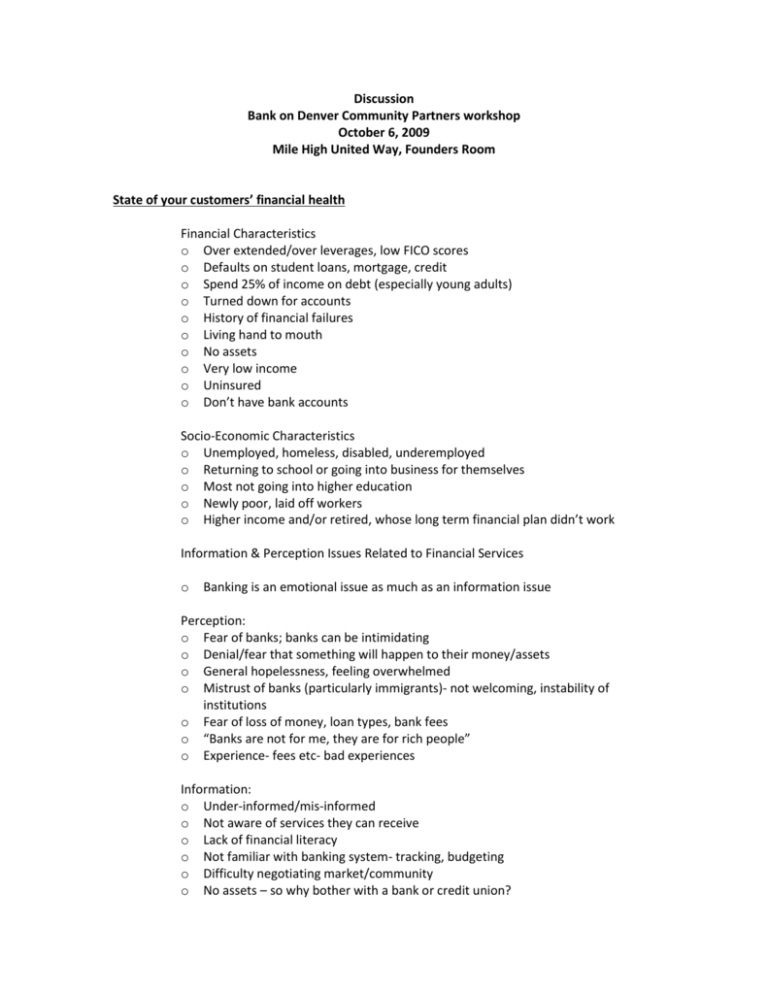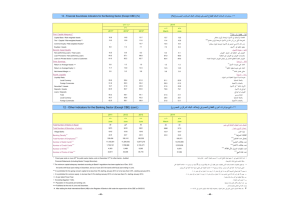State of your customers' financial health
advertisement

Discussion Bank on Denver Community Partners workshop October 6, 2009 Mile High United Way, Founders Room State of your customers’ financial health Financial Characteristics o Over extended/over leverages, low FICO scores o Defaults on student loans, mortgage, credit o Spend 25% of income on debt (especially young adults) o Turned down for accounts o History of financial failures o Living hand to mouth o No assets o Very low income o Uninsured o Don’t have bank accounts Socio-Economic Characteristics o Unemployed, homeless, disabled, underemployed o Returning to school or going into business for themselves o Most not going into higher education o Newly poor, laid off workers o Higher income and/or retired, whose long term financial plan didn’t work Information & Perception Issues Related to Financial Services o Banking is an emotional issue as much as an information issue Perception: o Fear of banks; banks can be intimidating o Denial/fear that something will happen to their money/assets o General hopelessness, feeling overwhelmed o Mistrust of banks (particularly immigrants)- not welcoming, instability of institutions o Fear of loss of money, loan types, bank fees o “Banks are not for me, they are for rich people” o Experience- fees etc- bad experiences Information: o Under-informed/mis-informed o Not aware of services they can receive o Lack of financial literacy o Not familiar with banking system- tracking, budgeting o Difficulty negotiating market/community o No assets – so why bother with a bank or credit union? o o o People think that they do not have enough money to bank Parents are not knowledgeable or connected Concern about EITC and its affects on building assets Product & Services Issues o Flexibility of products/hours o Language barriers o Employees pay fees Vision statement about use of financial services Systemic o Open the spigot on trickle down o Inform consumers of options, taking appropriate actions, part of a system that is transparent, supportive and interested o Banking services where people are – not geographically but financially – what services meet their needs as opposed to people who are already in the mainstream financial system o Finding products that meet the needs of consumers o People can have access if they want it o A pathway o Safe, affordable place to save money o Convenient; easy, simple o Hours of convenience- having access when you need it o Access to education, including budgeting o Financial education to include values and financial goals that are linked to people’s values o Convenience, access, quality of service equitable o Education about products and services o One trusted source that is marketed Can answer questions about credit, banking etc Linked resources o Flexible product features o Transparent o Timely services-hours, stages of life- global o Value vs. goal based services/products (graduated steps) o Safety net; 1st responders (trusted individual who makes bridge) or non profits who understand Bank on Denver Customer Based o People understand options o Understand benefits o No use of tax Refund Anticipation Loans (RALs) or rapid refunds o Education that leads to better choices o Changed behaviors o Knowledge of products o o o o o Ability to make educated decisions—feelings of empowerment Multigenerational model Basic financial knowledge: k-12 Understand asset-building strategies Gaps/barriers/opportunities Systemic o Time consuming transportation o Do financial institutions want these clients—what is their payoff? o Role of non-profit—staff time o Need to push financial institutions (they are going to say they already have these products) o Combine easy access with lower costs? o Language barrier o Lack of single source of information o Coordination of banks/credit union providers o Lack of education in bank people as well as in clients and relation to one another o Tiered service system o Uninformed agency staff o Status quo is ok- used to it o Opposition to using a third-party, go-between o No “easy” button o Anticipated risk o Continuity of financial education o Education to/of financial institutions of customers’ challenges o Lack of money for service providers-competition, not collaboration (needs coordination) o Advocacy- steering towards products build for them “banking bill of rights” Customer Based o Computer access/computer literacy o Privacy/cultural embarrassment o Income o Education o Institutional fear o Eligibility for credit o Avoidance of discussion of money o Language barrier o Money for program o Lack of knowledge/literacy to understand contracts o Status quo is ok- used to it o Opposition to using a third-party, go-between o Disability financial planning o Coordinated communicated system-inclusive o o o o o No “easy” button Too many options=shut down Anticipated risk Lack of time for literacy Literacy with financial terminology Opportunities o Leverage of VITA sites o Certification of financial education instructors o Integration of financial education into ESL and other programs o Incentives, combined classes, IDAs o Evaluate successful marketing/products of fringe services to guide products/marketing o Multiple education modalities: classes, online marketing messages, conversation guides/staffers o Mi Casa- Bilingual Bank tellers- cultural comps and guides o Asking community partners (workforce perspective) to check in with clients Existing Services/Programs o o o o o o o o o o o o o o o o o o o o o o o o o o o Many financial literacy programs Agencies offering pieces of money management Training agencies for employment/career information and financial planning Consumer credit counseling Credit repair loans and education Credit unions’ education programs Banks -community education/service IDA program VITA/EITC Microcredit loan programs Matched savings Micro finance-loan programs Payday loans Rent to own Pawn shops Operation HOPE (education in schools) and Junior Achievement Colorado Saves Money management International Operation Frontline Waddell and Reed College Invest Mi Casa- workforce development, homebuyers, ESL, youth IDA, family National Endowment for Financial Education (NEFE) Colorado Disability Economic Initiative Money Smart curriculum—credit unions/banks Foolproof Denver Venture School o o o Education programs at housing developments - Mercy housing DHA-programs 211 New ideas Products o Lottery/incentives for savings- “Save to win” o More flexible banking products (smaller loans’ no fees for low balance) o Check cashing Lower fees Expanding into other services Bill pay, wire transfers Pawn brokering o Receive a bonus for opening an account o No/low fees o Mobile money! o Debit cards o Value vs. goal based services/products (graduated steps) o Flexible product features o Transparent o Default/foreclosure o Home improvement loans Services o Banks care about families’ needs- hours of operation/head of household o Change the relationship between banks and depositors (ask for fee not take) o K-12 financial literacy- know how to keep a checkbook, fill out forms o Credit Union services - reducing/eliminating fees and penalties o Personal banker o Branches of credit unions in new locations o Pre-application from home or on web o Hours of convenience- having access when you need it o Timely services-hours, stages of life- global o Timely services-hours, stages of life- global o Financial education to include values and financial goals that are linked to people’s values o Consumer credit counseling—integrate into work force development agencies o Mobile banking Education o Boot camp on credit repair and debt management o Incentives Gift cards for attending classes Food o o o o Tour the vault Mandate financial education in schools K-12 financial literacy- know how to keep a checkbook, fill out forms Financial literacy Greater continuity more informal thinking, outside the box instructor certification Pre/post buyer counseling & buyer workshops Outreach o Community meetings regarding: how do we make decisions? o Door to door outreach, assessment, referral (train community members for this; Denver Health Community Voices model) o Building family groups Educating kids along with parents o Reach kids through parents and vice versa o Combined adult/youth financial classes in classrooms Parents night Indirect training o Positive peer culture Savers groups- consciousness raising o Bank on Denver Representatives at the bank Developing community leaders o One trusted source that is marketed - trusted intermediary Can answer questions about credit, banking etc Linked resources Other Strategies o Combine financial and health information o Economic success coach in every school to work with families and kids ($3.9 million estimated cost) o City wide credit score—aggregated credit score- competition/contest among number of accounts, neighborhoods, cities, thermometer (everyone is cheering for the same cause Tie in with other goals o Bank Customer approval rating- A,B,C; 4 stars etc o Getting people interested in finances- barriers we need to understand







